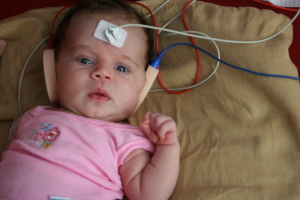What is Ultrasound?
Ultrasound is like ordinary sound except it has a frequency (or pitch) higher than humans can hear. When sent into your body from a transducer (probe) resting on your skin, the sound is reflected off internal structures. The returning echoes are received by the transducer and converted by an electronic instrument into an image on a monitor, similar to a television screen. These continually changing images can be recorded on videotape or film. Diagnostic ultrasound imaging is commonly called sonography or ultrasonography.
Who Will Perform the Examination?
The examination is usually performed by a specially trained health care professional called a sonographer. A series of images will be recorded by the sonographer. These images will then be interpreted by a doctor. In some cases, you may be examined by a doctor to confirm or resolve uncertain findings.
Will the Ultrasound Exam Hurt?
There is no pain involved in an ultrasound examination, although you may experience some pressure or discomfort when having a sonogram of certain parts of your body. During the scanning procedure, a gel is applied over the area to be examined and a transducer is placed on your skin or, for certain examinations, inserted into your vagina. The gel may feel cool. It is water soluble and usually wipes off easily, but it is a good idea to wear clothing that is easily washable.
When and How Is Ultrasound Used in Pregnancy?
Common uses for ultrasound in most medical practices would be:
- Confirming the pregnancy
- Dating the pregnancy
- Genetic screening (1st trimester)
- Targeted screening- looking for physical anomalies and gender (2nd trimester)
- Locating the placenta-especially relevant for women considering VBAC
- Bio Physical Profile (BPP)-evaluates the well being of the baby (post-dates or by clinical indication)
- Hand held or bed side fetal monitoring in labor
Is Ultrasound Safe?
Ultrasound safety is still being studied. There are known effects associated with the medical use of sonography such as temperature and cellular changes, but they are not considered “harmful”. Widespread clinical use of diagnostic ultrasound for many years has not revealed any conclusive harmful effects and studies in humans have revealed no direct link between the use of diagnostic ultrasound and any adverse outcome.
Ultrasound use in pregnancy is considered safe in the medical model and is controversial in the midwifery community. There is research to support strong caution against routine ultrasound use, especially in the first trimester of pregnancy. A well researched article on the concerns surrounding ultrasound use in pregnancy appears in Mothering Magazine ![]()
What the FDA has to say:
A United States Food and Drug Administration (FDA) report1 states that ultrasound has been used for many years with no obvious detrimental effects. Nevertheless, current evidence is considered insufficient to justify an unqualified acceptance of ultrasound safety. The FDA report recommends that ultrasound be used only when a diagnostic benefit is likely, and that exposure should be limited to that required to produce the needed information.
The World Health Organization (WHO) of the United Nations, in its report on ultrasound,2 recommends prudence in ultrasound exposure to human subjects but agrees that benefits outweigh any presumed risks. The WHO report states that patients should be examined with ultrasound only for valid clinical reasons.
With regard to ultrasound scanning during pregnancy, the FDA states that "ultrasonic fetal scanning is generally considered safe and is properly used when medical information on a pregnancy is needed. But ultrasound energy delivered to the fetus cannot be regarded as completely innocuous. Laboratory studies have shown that diagnostic levels of ultrasound can produce physical effects in tissue, such as mechanical vibrations and rise in temperature. Although there is no evidence that these physical effects can harm the fetus, public health experts, clinicians, and industry agree that casual exposure to ultrasound, especially during pregnancy, should be avoided. Viewed in this light, exposing the fetus to ultrasound with no anticipation of medical benefit is not justified."3
In conclusion, based on experimental and epidemiological data, there is presently no identified risk associated with diagnostic ultrasound. However, a prudent and conservative approach is recommended in which diagnostic ultrasound should be used only for medical benefit and with minimal exposure.
Where can I get an ultrasound during my pregnancy?
Motherland Midwifery clients can obtain ultrasounds at the Philadelphia Pregnancy Center where we can send a referral on your behalf at your request. You may also pursue this testing through a hospital-based OB practice.
1 US Department of Health and Human Services, Public Health Service, Food and Drug Administration: An Overview of Ultrasound: Theory, Measurement, Medical Applications, and Biological Effects. Publication # FDA 82-8190. http://www.pubmedcentral.nih.gov/articlerender.fcgi?artid=1995002 ![]()
2 Environmental Health Criteria 22: Ultrasound. World Health Organization: Geneva, 1982, p 19.
3 US Food and Drug Administration, Center for Devices and Radiological Health, Diagnostic Devices Branch. Fetal Keepsake Videos. Available at: http://www.fda.gov/MedicalDevices/Safety/AlertsandNotices/PatientAlerts/ucm064756.htm ![]()
